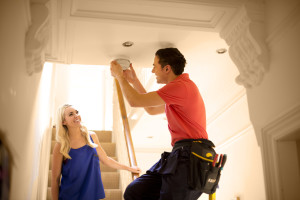 When it comes to HVAC, Orlando homeowners often focus on their air conditioning. But every year, approximately 20,000-30,000 people are victims of carbon monoxide poisoning, with 10,000 of these seeking medical treatment and 1,500 people dying from exposure, making it the top cause of accidental poisoning in the US. Caused by incomplete fuel combustion, this odorless gas can be produced in appliances that are poorly vented or functioning improperly. This can include furnaces, fireplaces, wood stoves, water heaters, ranges, generators and vehicles. How do you recognize carbon monoxide poisoning and how can you protect your family? Here are some tips to keep in mind:
When it comes to HVAC, Orlando homeowners often focus on their air conditioning. But every year, approximately 20,000-30,000 people are victims of carbon monoxide poisoning, with 10,000 of these seeking medical treatment and 1,500 people dying from exposure, making it the top cause of accidental poisoning in the US. Caused by incomplete fuel combustion, this odorless gas can be produced in appliances that are poorly vented or functioning improperly. This can include furnaces, fireplaces, wood stoves, water heaters, ranges, generators and vehicles. How do you recognize carbon monoxide poisoning and how can you protect your family? Here are some tips to keep in mind:
Signs of Carbon Monoxide Poisoning
There are several symptoms to be aware of, including nausea and vomiting, headache, weakness, dizziness, blurring vision or visual distortions, confusion, shortness of breath or tightness in the chest, loss of muscle control, skin redness, sleepiness and loss of consciousness. Because these symptoms can closely resemble that of the flu, it’s important to note if more than one person is suffering the symptoms or if the symptoms ease when you’re away from that area. If you suspect carbon monoxide poisoning, leave your home, leaving as many doors and windows open as possible, then call 911. Carbon monoxide poisoning can quickly escalate and leave you unable to call for help if you attempt to do so from inside your home.
How to Prevent Carbon Monoxide Poisoning
One way to avoid carbon monoxide poisoning is to install a carbon monoxide detector. If you decide to go with a wired model, make sure it has a battery backup. During a serious ice storm in North Carolina, hundreds of wired carbon monoxide detectors were not functioning during the 9 days the storm raged. Families desperate for heat brought a number of combustion appliances, including BBQ grills, into their homes. With the power out, the detectors did not function properly and 124 people suffered severe carbon monoxide poisoning during the storm. In multi-unit homes, carbon monoxide can pass between units. It’s recommended that the detectors be installed at a minimum of one per floor, preferably above or near fuel-burning appliances, and to include one in an attached garage, where exhaust can cause carbon monoxide to build up. Make sure you change your carbon monoxide detector batteries when you change your smoke detector batteries in the fall.
Other ways you can reduce the chance of carbon monoxide poisoning is to keep all appliances in good order, never using a gas oven to heat the home, not using outdoor-only devices in the home and never idling a car inside a garage even with the garage door open. Having your heating system tuned up every year helps prevent carbon monoxide as well. If you haven’t had your system tested recently, our Orlando HVAC service can help. Contact us today for more details.




Speak Your Mind